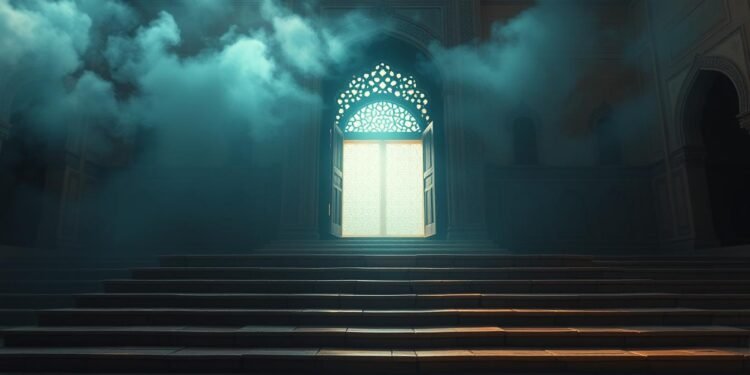In the serene silence that blankets the night, lies a moment etched in spirituality that draws the ardent believer closer to divinity. Imagine a time so potent that it is believed the Almighty descends to answer the prayers of those awake: this is the blessed last third of the night, the prime time for offering Tahajjud, the night prayer. As an eloquent author with the editorial team of CSAC.org.uk, I extend the warmth of knowledge to those who seek enlightenment. It is said that the Tahajjud prayer, a nafl or voluntary offering, has the potential to not merely guide but transform the lives of those who embrace its nocturnal rhythm.
The pious tranquillity in fulfilling at least two rak’ahs during these pre-dawn moments can extend to as many as the worshipper chooses, often culminating in twelve for those inspired by the devotion of Prophet Muhammad (PBUH). He is reported to have said that the best prayer after the obligatory ones is the prayer at night, an undeniable testament to the profound spiritual benefits that accompany these quiet, reflective hours.
With guidance on Tahajjud nestled in the teachings of Islam, this guide aims to illuminate the steps of Tahajjud and the inner peace it promises. Found within these pages, the desire for closeness to Allah meets practicality, as we explore the intricacies of night prayer. From the hadith highlighting Allah’s search for those invoking Him in the last third of the night, to the affirmation that consistent performers of Tahajjud are blessed with spiritual growth, the profound impact of this prayer is both an anchor and a voyage.
British English holds eloquence and grace, and so with ‘s’ we write and express this guide’s intent: to channel the grandeur of the night into words, lessons, and ultimately into the lives of our readers. Engaging in Tahajjud steps, one earns more than just the rewards of worship— they embark upon a journey of self-discovery, absolution, and fortitude against life’s tribulations.
By now, the statistics are not merely numbers; they are beacons for those yearning for a transformative experience. It is not just about when to pray, but also how to weave the fabric of Tahajjud into the tapestry of our daily living. Embrace this journey; embrace serenity, forgiveness, and the benevolence of nocturnal supplications. Welcome to a path less travelled, a path towards spiritual enlightenment.
Introduction to Tahajjud Prayer
The Tahajjud prayer, a profound expression of spiritual worship, is a voluntary nafl prayer deeply revered within the Islamic faith. This prayer is performed during the night, specifically after the Isha prayer and before the Fajr prayer, making it a special time when believers seek a closer connection with Allah. This period offers a serene opportunity for individuals to reflect, seek repentance, and strengthen their mental strength through intimate communication with their Creator.
Engaging in Tahajjud can significantly enhance a Muslim’s resilience and self-discipline, fostering qualities that are beneficial both in personal life and spiritual growth. It is recommended that during these precious moments, believers pour out their hearts in trust in Allah, seeking His guidance and forgiveness. The hours of the night, especially the last third, are seen as the most effective time for such prayers, as they are believed to be a moment when Allah descends to the closest heaven and listens more intently to His servants.
The structure of Tahajjud prayer often includes a series of Rakats, typically up to 11, allowing for substantial periods of meditation and supplication. This not only fosters a deeper sense of spirituality but is also a practice through which Muslims can transcend their daily concerns and commit to higher divine goals. As a result, many who regularly observe these prayers report enhanced clarity, tranquility, and a more robust ability to cope with life’s challenges.
Moreover, Tahajjud stands as a testament to a Muslim’s dedication and a strong act of spiritual worship that enriches their faith and augments their personal connection with Allah. Its non-compulsory nature highlights the extraordinary merit it holds, being a prayer that the Prophet Muhammad (pbuh) consistently performed, reflecting its significance and potential in nurturing one’s spiritual wellbeing.
The Significance of Tahajjud in Islam
Among the prayers that hold a profound position in Islamic teachings, Tahajjud stands out due to its unique timing and spiritual benefits. Referred to as Qiyam-u-lail, this voluntary prayer conducted during the latter part of the night exemplifies the Sunnah of Prophet Muhammad and is highly emphasized in both the Holy Quran and Hadiths.
References in the Holy Quran
The Holy Quran frequently underscores the spiritual and communal rewards of those engaging in night prayers. Verses such as 17:79 and 25:64 encourage believers to forsake their beds and invoke their Lord in hope and fear, and the promise that Qiyam-u-lail could elevate them to a praiseworthy station (maqam-e-mahmud) as indicated in 52:49.
“And from [part of] the night, pray with it as additional [worship] for you; it is expected that your Lord will resurrect you to a praised station.” (Quran, 17:79)
Hadiths Highlighting its Importance
Prophetic traditions provide ample narratives that reflect the merits of performing Tahajudd. One of the notable Hadiths from Sahih al-Bukhari (1145) elaborates on the virtue of night-time prayers over other non-obligatory prayers, marking it as a clear exemplar of devout worship preferred during the hours shrouded in darkness. Furthermore, reports showcasing the Prophet Muhammad’s own practice, such as standing for almost two-thirds from the night, inspire followers to adopt this commendable act.

- Hadiths narrate that upon fleeing the three knotted influences of Satan through the remembrance of Allah, performing ablution, and praying, believers will feel energetic and lively despite the late hours (Hadith 1142).
- Through consistent practice, reverent individuals like Tamīm b. Aws were known to repent missing Tahajjud by engaging in extended hours of prayer, demonstrating the prayer’s profound personal and spiritual impact.
- The example set by early scholars and devout followers like Imām al-Shāfiʿī, who partitioned his night into dedicated sessions of sleep, study, and prayer, highlights a balanced approach towards fulfilling one’s spiritual duties.
These references from both Holy Quran and Hadiths clearly showcase the irreplaceable role of Tahajjud in enhancing one’s devotion and closeness to Allah, marking it as an essential endeavor for those forging a path towards spiritual enlightenment within Islamic teachings.
When to Pray Tahajjud
The practice of Tahajjud prayer holds a revered spot in Islamic spiritual discipline, particularly due to its timing and the profound connection it offers the worshippers with the divine. Understanding the optimal prayer timings for Tahajjud is essential for anyone looking to enhance their spiritual practice. The most spiritually potent period for this prayer is during the last third of the night, just before the break of dawn.
This period is significantly highlighted in the teachings of Islam as a time when Allah is closest to the Earth, readily responding to prayers and supplications. It is within these serene, pre-dawn moments that Muslims find a profound opportunity for introspection and seeking divine mercy, adding a layer of depth to their spiritual discipline.
The guidance laid out indicates structuring the night for those who keenly follow a worship schedule. Dividing the night into thirds provides a systematic approach: the first part for sleep, the second for reflection or rest, and the vital last third reserved for Tahajjud. This schedule harmonises daily routines while prioritising spiritual elevation.
For practical understanding, consider a night where dusk (Maghrib) sets at 6:00 PM and dawn (Fajr) breaks at 6:00 AM. In such a case, the last third of the night, which is prime for Tahajjud, would begin around 2:00 AM and end at 6:00 AM. Adhering to these timings does not just fulfill a ritualistic practice but enriches the believer’s faith, bringing them closer to achieving spiritual tranquility and divine closeness.

To further enrich one’s commitment to this prayer, it is advised to start with two short units (rakats) of prayer, gradually extending as one becomes more engrossed. This incremental approach not only makes the practice manageable but also deeply fulfilling. Thus, by integrating Tahajjud into their nightly routine, believers can truly harness the benefits of this profound worship experience.
How to Pray Tahajjud
In delving into the nocturnal practice of Tahajjud, we explore a discipline revered for its solemn nature and spiritual potency. A night prostration, where solitude meets divine communion, Tahajjud namaz rakat may range from at least 2 and so on, traditionally observed in pairs, up to a recommended 8 rak’ahs. Initiated with a pure heart and mind, the process entails waking during the third part of the night after segmenting one’s rest according to prophetic guidance, thus harnessing the serenity that prevails under the blanket of stars. Performing the Wudu with meticulous care, one whispers their Niyyah to Allah, setting the intention as personal as the silent hours around.
The Tahajjud prayer unfurls with the reverent Takbir, followed by the lyrical verses of Surah Al-Fatiha, and subsequently another chapter from the noble Quran, each syllable melting into the tranquil night. Ruku and Sujood — the bowing and prostration — intertwine with prayer verses, binding the worshipper to their faith steadfastly. The culmination arrives with the Tashahhud and Salaam, a profound conclusion to the ritual steps. Yet, the spiritual embrace does not cease here, as the exercise is crowned with the Witr Salah, a seal over the night’s devotion, completed in odd-numbered rak’ahs, following the sunnah of the Prophet Muhammad (PBUH), who consistently accentuated its performance.
Forging a connection with the divine in these pre-dawn moments is known to carry an extraordinary grace. For believers who travail against slumber’s comfort, the rewards are manifold, encompassing the mitigation of sins, a bolstered resolve against worldly vices, and forging an intimate closeness to Allah. The dua whispered in the stillness of Tahajjud is a powerful recourse, as the Hadith elucidates that there exists an hour each night where any Muslim’s plea is granted. With consistency and fortitude, the layers of nocturnal worship unfurl to yield both temporal tranquility and the promise of eternal grace.












